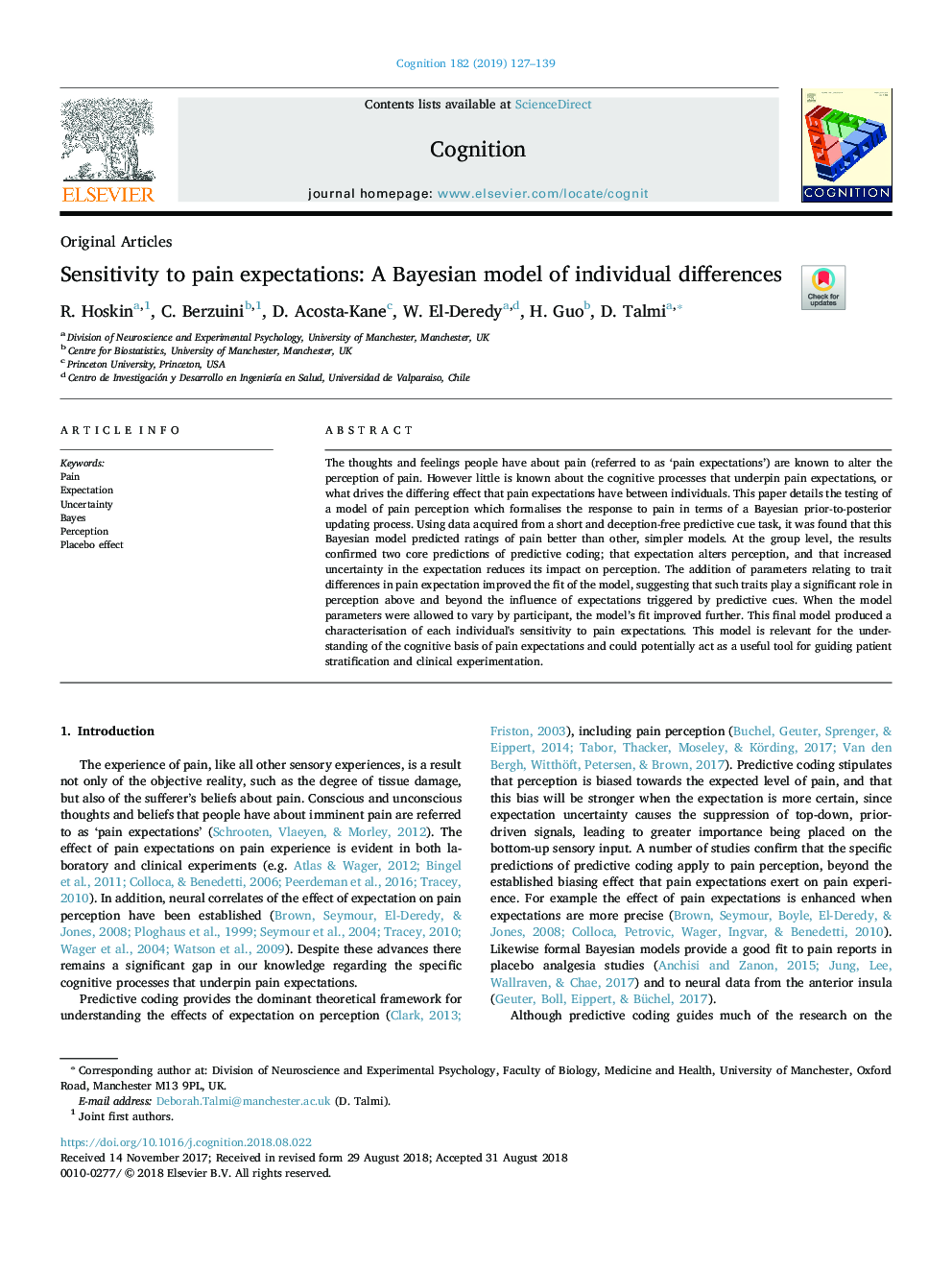| کد مقاله | کد نشریه | سال انتشار | مقاله انگلیسی | نسخه تمام متن |
|---|---|---|---|---|
| 10147056 | 1646431 | 2019 | 13 صفحه PDF | دانلود رایگان |
عنوان انگلیسی مقاله ISI
Sensitivity to pain expectations: A Bayesian model of individual differences
ترجمه فارسی عنوان
حساسیت به انتظارات درد: مدل بیزی برای تفاوتهای فردی
دانلود مقاله + سفارش ترجمه
دانلود مقاله ISI انگلیسی
رایگان برای ایرانیان
کلمات کلیدی
درد، انتظار، عدم قطعیت، بایر، ادراک، اثر پلاسبو،
ترجمه چکیده
افکار و احساسات مردم در مورد درد (به عنوان انتظارات درد شناخته می شود) شناخته شده است که درک احساس درد را تغییر دهید. با این حال، کمی در مورد فرآیندهای شناختی که زمینه انتظارات درد را فراهم می کنند، و یا چیزی که اثر متفاوتی را که انتظارات درد را بین افراد در اختیار دارد، شناخته شده است. این مقاله جزئیات آزمایش یک مدل درک درد است که پاسخ به درد را از لحاظ فرآیند به روز رسانی قبل از خنثی بیزی رسمی می کند. با استفاده از داده های به دست آمده از وظایف پیش بینی شونده کوتاه و بدون فریب، مشخص شد که این مدل بیزی، رتبه های درد را بهتر از سایر مدل های ساده تر پیش بینی می کند. در سطح گروه، نتایج دو پیش بینی اصلی پیش بینی برنامه نویسی را تایید کرد؛ این انتظارات باعث تغییر درک می شود و عدم اطمینان در انتظار افزایش تاثیر آن بر روی ادراک را کاهش می دهد. علاوه بر این، پارامترهای مربوط به تفاوت های صفت در انتظار درد، مناسب بودن مدل را بهبود بخشید، و این نشان می دهد که چنین صفاتی نقش مهمی در ادراک بالاتر و فراتر از تأثیر انتظاراتی که توسط نشانه های پیش بینی شده بوجود می آیند. هنگامی که پارامترهای مدل مجاز به تغییر توسط شرکت کننده بود، مدل مناسب تر شد. این مدل نهایی، توصیف حساسیت هر فرد را به انتظارات درد می دهد. این مدل برای درک مبانی شناختی انتظارات درد مناسب است و به طور بالقوه می تواند به عنوان یک ابزار مفید برای هدایت طبقه بندی بیمار و آزمایش بالینی عمل کند.
موضوعات مرتبط
علوم زیستی و بیوفناوری
علم عصب شناسی
علوم اعصاب شناختی
چکیده انگلیسی
The thoughts and feelings people have about pain (referred to as 'pain expectations') are known to alter the perception of pain. However little is known about the cognitive processes that underpin pain expectations, or what drives the differing effect that pain expectations have between individuals. This paper details the testing of a model of pain perception which formalises the response to pain in terms of a Bayesian prior-to-posterior updating process. Using data acquired from a short and deception-free predictive cue task, it was found that this Bayesian model predicted ratings of pain better than other, simpler models. At the group level, the results confirmed two core predictions of predictive coding; that expectation alters perception, and that increased uncertainty in the expectation reduces its impact on perception. The addition of parameters relating to trait differences in pain expectation improved the fit of the model, suggesting that such traits play a significant role in perception above and beyond the influence of expectations triggered by predictive cues. When the model parameters were allowed to vary by participant, the model's fit improved further. This final model produced a characterisation of each individual's sensitivity to pain expectations. This model is relevant for the understanding of the cognitive basis of pain expectations and could potentially act as a useful tool for guiding patient stratification and clinical experimentation.
ناشر
Database: Elsevier - ScienceDirect (ساینس دایرکت)
Journal: Cognition - Volume 182, January 2019, Pages 127-139
Journal: Cognition - Volume 182, January 2019, Pages 127-139
نویسندگان
R. Hoskin, C. Berzuini, D. Acosta-Kane, W. El-Deredy, H. Guo, D. Talmi,
